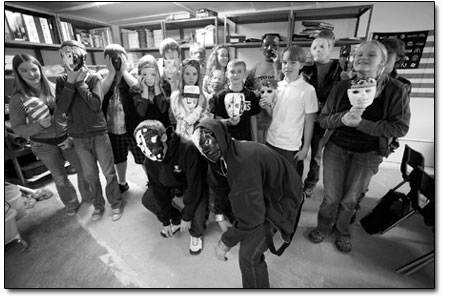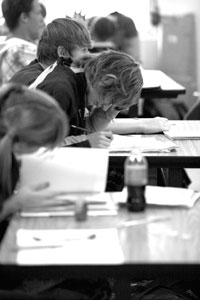|
| ||||
| Inside Animas High School
by Anna Thomas The new Animas High School is quietly taking shape, sandwiched between a Chinese buffet and a SCUBA shop in an unassuming Durango strip mall of all places. The renovated space, formerly a maze of partitioned medical offices, is now home to 10,000 square feet of classrooms – classrooms in which 75 freshmen are being exposed to a new kind of education. The high school features an innovative curriculum of “project-based” learning and community involvement. The curriculum is modeled after that of the highly successful High Tech High, in San Diego. HTH boasts 15 percent higher scores on standardized tests than traditional high schools, with 99 percent college acceptance upon graduation. “I have moms come up to me in tears at City Market,” says head of school Michael Ackerman. “They say, ‘Little Johnny actually likes school! Whatever you’re doing, it’s working!’” The Animas High students’ most recent project involved Durango Fire and Rescue. Fire Marshall Tom Kaufman put on a “Hydraulics 101” course at the school, in which students learned the science behind the water pressure of the city’s hydrants. The students then painted 200 hydrants around town, color-coding them according to pressure, thereby making the engineer’s job easier by knowing at a glance which hose to pull in a fire. In the course of such a project, says Ackerman, the students not only receive a physics lesson, but get firsthand exposure to the value of community service. One of the founding principles of this model is the integration of technology into the learning process. “Education has historically been sluggish to react to technology,” says Ackerman. The incorporation of technology, such as laptops, digital media and the internet, is vital in “making our country competitive in the global climate,” Ackerman claims. A walk through the school’s digital media lab offers insight into the school’s unique approach to education. Atop the “Tinker Table” is a dismantled fax machine, with a note from one of the teachers telling students to “see me if this really interests you.” Even after school lets out, students huddle around the computers, updating their “digital portfolios,” or individual webpages, on which all school-related work is posted. Downstairs, formerly a parking garage, there is a laptop for every student in Cathy Cullicott’s math and science room. A quote by Jackie Chan on the wall urges kids to “Study with all your might … and never stop fighting to reach your dreams.” While the students are currently learning about Newton’s First Law on a planetarium website, Cullicott’s background as a geologist will be influencing their next assignment. Standing in front of a poster of an erupting volcano and corresponding seismograph, Cullicott says, “The eruption of Mount St. Helen’s was a turning point in my life.” The next project? Studying the physics of waves, amplitude and frequency through the lens of seismography. One of her students is the daughter of a Fort Lewis College geology professor who has volunteered to contribute his expertise to the project. Next door, in the humanities room, kids work on “identity masks.” The project calls for students to create a plaster of Paris mask reflecting society’s influence on identity while concurrently writing an essay on the same topic. Freshman Sam Kater’s mask advertises cogito ergo sum on its cheek. “‘I think, therefore I am,’” explains the teen-ager, who adds, “It’s Descartes.” Humanities instructor and High Tech High transplant John Fisher oversees the activity. “You get to teach your passion,” Fisher says, echoing Cullicott’s enthusiasm. The next project stems from Fisher’s love of the book Gates of Fire, about the battle of Thermoplyae, upon which the movie “300” is based. The kids will construct “artifacts,” write historical fiction stories, and use Photoshop to design characters that would have lived in an ancient civilization of their choosing.
When projects like the identity masks are finalized, they are presented to the public at a community exhibition. The students are required to display their work and be on hand to answer questions. The experience of public presentation and critique exposes kids, says Fisher, to the social pressures of the real world. In addition to classroom projects, the curriculum incorporates electives and physical education activities suggested by the students. Reflecting the unique social environment of Durango, students get the opportunity to go rock climbing, practice yoga, make a documentary and learn about beekeeping. Parents, says Ackerman, often express concern over whether or not Animas High’s model addresses the standards. And, in the absence of traditional, test-based assessment, if their son or daughter will be prepared for the CSAP. Ackerman explains that all the state standards are met, but with a different approach. “Getting used to this type of educational model is like driving a new car,” says Ackerman. “You still get there the same way, it’s just going to feel a little different.” As for the CSAP, students also receive education on test-taking strategies, important for standardized, multiple-choice tests like the CSAP. But times they are a changing at the Colorado Department of Education. Traditional, grade-based standards are being modified to incorporate what Ackerman defines as “21st century skills.” These skills are defined by the Department of Education as “problem-solving, information literacy and innovation” and “the ability to take responsibility for additional learning, self direction and interaction with others to learn new information quickly and more naturally.” The emerging approach bears remarkable similarity to that of the educational model upon which Animas High is based. As Ackerman puts it, “Learning is not just about attaining information, but what you do with it once you’ve got it.” At the core of the approach, says Fisher, is accountability. “If kids are having a hard time with a project, they are held accountable to advocate or modify their project.” As to the student perspective, Freshman Sergio Verduzco asserts, “I’ve never been so engaged in learning.” This mentality stretches across educational bounds and into the social lives of students. Mathew Longwell, who admittedly let his grades slip at the beginning of the year, has since improved his performance. Of the culture of social acceptance, Longwell says, “There is no room for That the melting pot of expected high school cliques allows for such a culture of tolerance is a source of pride for Ackerman. “We have 13-year olds using ‘I’ statements!” Next fall, this year’s students will enter their sophomore year, as a new crop of freshmen take their place. The school has plans for more teachers, and more classrooms, to accommodate a new class each year, up to a maximum of 400 students. After that, Ackerman expectantly declares, “We’ll just build another school!” •
|



